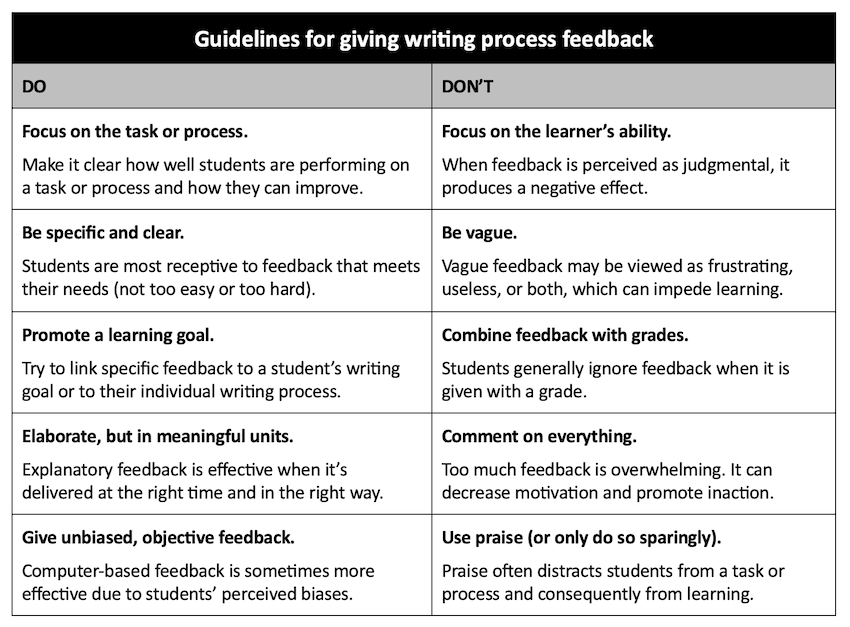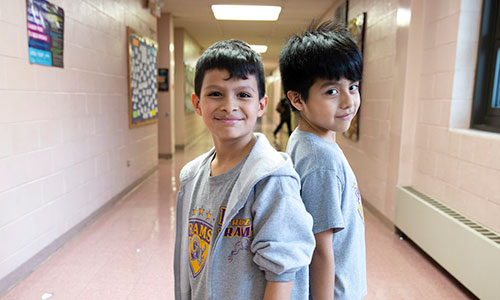
Have you ever taken a piece of writing on your computer and dropped it wholesale into the recycle bin? Ever crumpled up a piece of paper full of writing and shot it at a trash can, hoping to make a basket? There’s something universally cathartic about being able to start over again—from scratch—with writing. Perhaps it’s because we learn something new as we write. And though our early failed efforts can be painful, they do point us in a new direction and get us closer to what we really want to say with our writing. When you give students feedback on their writing process, you can help them do just that.
Writing is a recursive process, not a linear one
Research shows that this idea of starting over with writing has merit. Writing is a recursive process, not a linear one. The recursive model was first proposed by Linda Flower and John Hayes in 1981, replacing the previous linear model I was taught in school, which involved outlining, completing a first draft, editing, completing a second draft, and so on, all in the same order each time.
In the recursive model, writers constantly move between cognitive processes, such as planning (setting goals, generating ideas, organizing ideas), drafting (putting a writing plan into action), and reviewing (evaluating, editing, revising). Writers move fluidly between these processes to accomplish specific, self-generated goals.
Writers change their goals based on what they learn through the act of writing
According to Flower and Hayes, writing goals change, and they are generated in one of two ways:
- The writer establishes high-level goals and supporting sub-goals based on their purpose for writing.These goals are often set before writing begins. For example, a high-level goal for a student in elementary school might be, “I want to tell my school principal about how moving more during the day is good for us, so I can ask for PE class every day instead of every other day.”
- The writer changes their writing goal, or creates a new goal, based on what they learn through the act of writing. For the same student, the evolution of their goal might look like this: “My research says that students need 60 minutes of physical activity a day, so my plan for PE class every day isn’t enough. I need to get creative. How can students move more throughout the day? If I start my letter with these ideas, I’ll really get my principal’s attention.” (Cue shot of crumpled-up piece of paper landing in trash can.)
Often, those tossed-out efforts are proof positive that we’re engaged in the writing process and, more importantly, learning from it!
Students and their teachers may learn more from feedback on the writing process than on the written product
Flower and Hayes also suggest that educators should give students feedback on their writing process—not just the written product—when they give students input. This is because it can provide more useful information for students and teachers than focusing on the written product alone. Here are five reasons why:
1. Proficient writing is closely linked to a writer’s ability to self-regulate
Self-regulation is the ability to manage your thoughts, emotions, and behaviors to achieve your goals. In writing, self-regulation involves managing your environment, behaviors, and personal thoughts to effectively plan, draft, and review your work.
Educational psychologists describe these fundamental forms of self-regulation in writing as follows:
- Environmental processes are the external conditions and resources that writers use to facilitate their writing. This includes managing the physical environment (like finding a quiet place to write), seeking feedback from others, and using tools and resources (such as dictionaries or writing software) to enhance writing quality.
- Behavioral processes are the actions and strategies that writers employ to improve their writing. These include goal setting and generation tasks like outlining, drafting, and revising. But they also include self-reinforcement, such as rewarding ourselves when we meet a writing goal (like treating myself to a piece of dark chocolate when I finish writing this blog!).
- Personal processes are the internal cognitive and emotional mechanisms that influence writing. These include beliefs (confidence in one’s writing abilities), motivation (the desire to accomplish a goal with one’s writing), and cognitive strategies (like planning and organizing). They also include emotional regulation, such as how we manage stress and maintain focus while writing.
These three forms of self-regulation interact in a cyclic feedback loop—a loop that gives students many opportunities to self-monitor and adjust their strategies based on what’s going well (or not so well) in their writing.
Unfortunately, traditional feedback methods for student writing often deprive students of these opportunities to become self-regulated learners. In many cases, self-reflection and dialogue produce more relevant feedback for students, as my colleague Gina Wilmurth writes about in “Speak up! How getting students to talk more can improve writing.”
2. Multilingual learners engage in distinct writing processes and benefit from varied feedback
Researchers have found that multilingual learners use distinct writing strategies compared to monolingual learners. These processes aid multilingual learners in navigating the complexities of writing in English by leveraging their full linguistic repertoires. For example:
- Multilingual learners frequently rehearse phrases and words to ensure accuracy and fluency in their writing. This helps them internalize and produce language in English that aligns with their intended meaning.
- Multilingual learners often switch to their native language to retrieve a specific word or idea because it provides access to a broader range of vocabulary and concepts, which can then be translated into English.
- Multilingual learners may revert to their native language to review their writing for coherence, checking that writing is logically structured and ideas flow smoothly.
It’s important to remember that the language students learn first is the bedrock upon which all other languages develop. That’s why empowering multilingual learners to use translanguaging during their writing process is so effective.
When providing feedback on writing to multilingual learners, the type of feedback matters, too. In a meta-analysis of 25 studies on this topic, peer feedback was found to be more effective than teacher feedback for non-native speakers of English. Non-native speakers also benefitted from more varied feedback than native speakers, including oral, written, and computer-based feedback. Finally, the analysis revealed that coaching students on the revision process improved the content of their writing more than giving feedback on a specific written product. For example, providing general explanations about grammatical patterns was more effective than identifying specific errors.
3. Feedback that promotes a growth mindset is more effective than feedback that highlights errors
While feedback generally leads to writing gains for all students, all feedback is not equal. Based on the body of research, some feedback leads to significant gains in learning, some has no effect, and some has a negative effect. Formative feedback, which is given directly to students as part of everyday teaching and learning, is the most effective feedback for writing.
Feedback that promotes a growth mindset (i.e., using effort to increase learning and accepting that mistakes are an important part of the learning process) is also effective. This is particularly true for low-achieving students because it draws a clear connection between effort and achievement (“My writing improved because I worked hard”), which leads to higher expectations for future writing tasks and more attention to effort. Unfortunately, a student’s growth mindset is rendered useless whenever we include a grade with our comments. Repeated studies show that grades alone and grades with comments produce no learning gains. However, comments alone—as is typical in a formative feedback cycle—can result in large learning gains.
4. How we frame feedback to students makes a difference
While formative feedback can improve students’ learning and enhance teachers’ teaching, this is only true when students are receptive to the feedback and the feedback is on target.
In one study involving tenth-graders, students didn’t understand what the feedback was intended to achieve. A teacher’s feedback on word choice, for example, was perceived as a request to use “bigger words” that would impress the teacher. Another study with seventh-graders, however, produced a different result. Researchers placed a handwritten sticky note on some students’ essays that read, “I’m giving you these comments because I have very high expectations and I know that you can reach them.” This simple reframing led to significant gains in writing quality, especially among African American students. Students who received these notes were 40% more likely than the control group to revise their essays and integrate the teacher’s feedback. Why? The sticky notes built trust between teachers and students.
Clearly, how we frame our feedback can make all the difference. That’s why well-known researchers Douglas Fisher and Nancy Frey have a new framework for creating a positive culture of feedback in the classroom. Their “4 C’s of Feedback” focus on care, credibility, clarity, and communication. They also address many of the issues I’ve noted in this article, such as the importance of one’s environment, building trust, and self-regulation. To learn more, watch the free webinar How Feedback Works.
In the meantime, when you give students feedback on their writing process, follow these dos and don’ts.

5. Feedback about the writing process is more likely to transfer to future writing tasks
There are many ways to give students feedback on their writing process effectively. What’s most important is to start, because students are more likely to transfer this feedback to future writing tasks. For a more holistic view, gather input from students, their peers, and adults who observe them writing. Start simply by asking students to rate a series of “I statements” on a four-point scale (strongly disagree, disagree, agree, strongly agree).
Here are 10 statements to get you started:
- I enjoy writing at school.
- I set goals when I am writing.
- It’s hard for me to come up with ideas when I write.
- I do not usually plan before I start writing.
- I can stay focused when I write.
- I like making changes to my writing.
- I do not like to share my writing with others.
- I write differently depending on who will read my writing.
- I know who I can go to for help with my writing.
- I believe writing is important in everyday life.
Students can revisit these statements throughout the year to track their growth as writers. Also, make sure that you take time during every writing conference to discuss a student’s writing process. During these conversations, you can suggest strategies that might help the student improve their process based on their specific needs (e.g., planning, staying focused, getting help).
And remember, there’s always room for improvement
The writing process first proposed by Flower and Hayes in 1981 was so influential that it spawned fourteen other models, including four revisions by Flower and Hayes to their original work. The lesson here is that there’s always room for improvement when it comes to teaching writing and supporting student writers. For example, more recent studies show that digital support for academic writing is most effective when it encourages students to self-monitor and develop their own writing strategies.
As an educator and writer, I’m excited about these new technologies that can aid us in writing. I’ll probably still feel compelled to toss out an early draft or two. But next time, I just might ask an AI chatbot what it thinks before I do.







